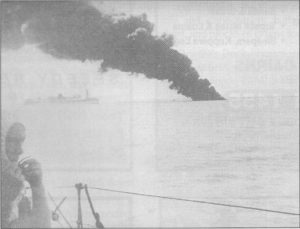- Author
- Lewis, Tom, AOM, Lieutenant RAN
- Subjects
- WWII operations
- Tags
-
- RAN Ships
- AHS Manunda, HMAS Mavie, HMAS Kara Kara, HMAS Kangaroo, HMAS Tolga, HMAS Swan III, HMAS Warrnambool I, HMAS Deloraine
- Publication
- June 2002 edition of the Naval Historical Review (all rights reserved)
Nine ships were lost on the 19th February 1942, seven within Darwin Harbour, and two in waters north of the harbour. Many others were damaged, and in the main, this was where most of the hundreds of casualties were killed and injured.
Stoker Frank Marsh was on board the corvette HMAS Deloraine, which was at anchor quite a distance from the wharf. He remembers seeing the first bombs falling into the sea between Deloraine and Neptuna very close to 10 am.
The harbour shipping was struck badly. The tanker British Motorist was sunk; so too were the coastal trader Zealandia, the lugger Mavie, and the US transports Meigs and Mauna Loa. A huge explosion marked the end of the transport Neptuna, which blew up alongside the wharf about an hour after the first raid ended as her 200 depth charges ignited.
Half a kilometre from Darwin’s wharf, the USS Peary’s captain was on the bridge of his ship when the Japanese fighters came sweeping in. Anchored, the four-funnel destroyer was an easy target, but the ship still had steam up. The Captain, Lieutenant-Commander John M. Bermingham, gave immediate orders to weigh anchor so he could head for searoom and present the attacking aircraft with a moving target.
The ship’s guns engaged the Japanese fighters but the vessel was hit almost immediately by five bombs and began to settle by the stem, her guns still firing. Her official history noted:
(Peary) was shaken (by) a blast which wrecked her fantail, demolished the depth charge racks, sheared off her propeller guards, and flooded her steering-engine room. She was next hit by an incendiary bomb which crashed into her galley and left Peary inflames.

According to Dallas Widick, a cable-party survivor, the anchor probably was never raised. Mel Duke, who was the Peary’s bosun’s mate, thinks that the anchor was “short stayed” – just resting on the bottom – and the rising tide lifted the ship enough to move her to the final sinking spot.
Finally, according to some reports, the ship was apparently blown up by a bomb that had hit her magazine and exploded there. Other suggestions include the theory that the ship’s depth charges exploded. Frank Marsh disagrees, saying: “… there were several explosions aboard Peary but not a final big sinking. It sank nearer to the hospital ship Manunda… It went down stern first.”
Fifty-two of the crew survived the sinking but 91 were killed – almost half of the total of people lost in the Darwin attack. Stories of the guns still engaging as the ship went down are borne out by Mel Duke’s memory of the galley-roof machine-guns firing, but not the forward gun, of which he was the captain.
The RAN’s ships were fiercely attacked, with one small vessel – HMAS Mavie – being sunk. Two of the harbour boom ships lost crew members due to strafing: HMAS Kara Kara two; the Kangaroo one sailor. Kookaburra was strafed and so too was the auxiliary minesweeper Tolga.
The sloop HMAS Swan was near-missed by a bomb and damaged. Twenty-two sailors were wounded and three killed on board. Corvette sailor Frank Marsh’s diary sums up the situation: “…ships sunk all around us and hundreds killed and wounded, a bloody terrible day. Second Pearl Harbour.”
Merchant Ships in Flames and Sinking
The tanker British Motorist received two direct bomb hits in the raid, catching fire and sinking quickly with a heavy list to port. Two men were killed in her sinking: the master and the wireless operator. Built in 1924 at Newcastle-on-Tyne shipyards, she had an overall length of 440 feet and was thus an easy target for the aircraft.
The Meigs was a US Armed Transport built in San Pedro, California, in 1921. She was the largest ship in the harbour during the raid and consequently was a primary target for the attacking aircraft. Lightly armed with guns on the forecastle, her 430-foot length was an easy mark and the ship was attacked extensively throughout the raid. The Third Officer later died in hospital of wounds received.




